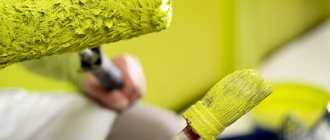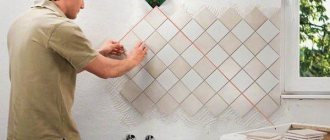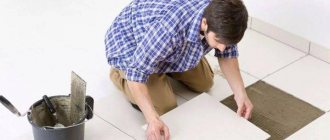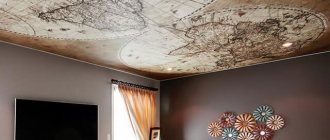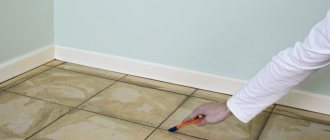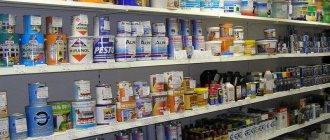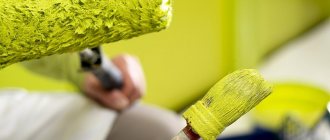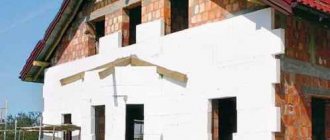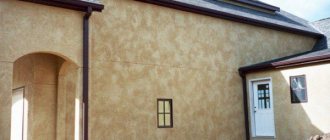Types of ceramic tiles
- enameled, or glazed and unglazed. The surface of the enameled tile is covered with colored glass. It gives the tiles shine and color. Glazed tiles can have a decorative pattern. In addition, the glaze makes the tile surface more durable and waterproof. Unglazed tiles are uniform over the entire surface. There are no drawings on it;
- porous or dense. The porosity of a tile is determined by the amount of water that its pores can absorb. The more water, the more porous the tile will be. However, do not think that porous tiles are covered with holes, like cheese. The pores are so small that they are only visible under a microscope;
- pressed or extruded. There are two technologies for making ceramic tiles - pressing and extrusion. In the first case, the tiles are made from a powder mixture. It is compacted under high pressure and formed from the resulting tile composition. In extrusion, the raw material is a dough-like mass, which is passed through a hole called an extruder to form tiles;
- with a red, white or colorless base. This parameter is more aesthetic than practical. The shade of the reverse, unpainted side of the tile depends on the color of the original raw material, i.e. clay. It can be colored (from pale yellow to deep red) or colorless or white.
Additionally, ceramic tiles vary in shape and size.
It can have the shape of a square, rectangle, hexagon, octagon. There are other, more exotic forms. The size of the tiles varies greatly: from small tiles, 10 × 10 cm, to large tiles, 60 × 60 cm or more. The thickness of ceramic tiles can reach 2 – 2.5 cm.
Recommendations for laying ceramic tiles
To properly lay ceramics, you must follow the following technological process:
- Work always starts from the far corner and is carried out towards the door.
- To simplify the process, it is recommended to install beacons and make markings.
- In uneven corners, tiles can be laid through a special plastic corner, which partially compensates for surface errors.
- At the final stage, the base row is laid out, which levels out all the unevenness.
After laying the tiles, the gaps are filled with grout mixture.
Majolica tiles
Majolica is a glazed tile with a porous colored base. It is made by pressing and is characterized by increased strength. The raw material is a mixture of clay, sand, carbonate and iron oxide, due to which the body of the tile has a pinkish tint. Only colored glaze is used. Majolica with a transparent coating is not produced. Majolica undergoes two separate firings: the first for the body of the tile, the second for the enamel.
Thanks to this treatment, the tiles are perfectly smooth, shiny, without bubbles or cracks on the surface. The most popular sizes of majolica are 15 × 15, 15 × 20 and 20 × 20 cm. Majolica is a porous tile. Its water absorption is 15 – 20%. This is quite a lot, so this tile is not suitable for rooms with high humidity (bathroom, toilet, etc.). It is used to line the walls of residential premises with low humidity.
If the thickness of the adhesive layer should be less than 1 cm, it is more convenient to distribute the adhesive over the base with a notched trowel to reduce product consumption. If the planned thickness of the adhesive layer is within 1-1.5 cm, it is more convenient to use a regular spatula.
Dimensions
As you know, tiles can be used for walls and floors. Their dimensional characteristics are completely different.
Wall tiles can be square or rectangular.
- The square shape is characterized by the following dimensional lines in cm - 15×15, 10×10, 20×20;
- The rectangular standard is 20×30 cm, but also produced and in demand are 2.5×15, 7.5×15, 10×15, 10×20, 15×20, 15×22.5, 25×30, 25 ×33.3, 27.5×40, 15×90, 30×90.
The average weight of ceramic tiles for interior walls per 1 square meter is from 12 to 16 kg. For facades - from 15 to 20 kg.
The thickness of the wall tiles is from 4 to 9 mm.
Most often, square tiles measuring 30x30 cm are used for flooring.
But with all that, it has a wide range of sizes and shapes.
- Square: 4.8x4.8 cm, 10x10 cm, 15x15 cm, 20x20 cm, 25x25 cm, 32.7x32.7 cm, 33.3x33.3 cm, 40 ×40 cm, 50×50 cm, 60×60 cm, 70×70 cm and so on, up to 100×100;
- Rectangular: 10×20 cm, 15×20 cm, 15×30 cm, 20×30 cm, 20×40 cm, 30×40 cm, 30×60 cm;
- 4-sided - 7.5x17.3 cm, 8.5x19.6 cm, 10x23 cm;
- 5-sided: 9.8x17 cm, 11.5x20 cm;
- 6-sided: 15×17.3 cm, 17×19.6 cm, 20×23 cm;
- 3-angled: 5.8×8.3 cm, 68×97 cm, 83×118 cm, 98×139 cm;
- 8-sided - 6x8.5x17 cm, 7x10x20 cm.
The average weight of ceramic tiles for a regular floor is 15–25 kg per square meter. meter, for rooms with increased load - 70 kg.
The thickness of flooring materials depends on their type:
- Regular tiles - from 6 mm to 1.1 cm;
- Increased strength - 2.5 cm;
- Porcelain tiles - from 4 to 14 mm.
The bending strength properties of ceramic tiles depend on the thickness parameters.
Mosaic tiles have a dimensional line - 1x1 cm and 5x5 cm. Thickness - 2-4 mm.
Earthenware tiles
Earthenware tiles are enameled tiles with a white porous backing. Like majolica, earthenware tiles are made by pressing and undergo double firing. To make earthenware tiles, only light clay without iron impurities is used. Therefore, the back side of such tiles is always colorless or white. Only its front glazed side is painted.
The most popular sizes of faience tiles are 15 × 20, 20 × 20 and 30 × 30 cm.
This type of tile is used for interior cladding of floors and walls.
The quality of earthenware tiles depends on how homogeneous the raw materials for their manufacture were. Adherence to technology also plays a big role. According to the rules, firing of earthenware tiles should be carried out in a stepwise manner. The material is exposed to a certain temperature for a certain time. Violation of technology leads to deterioration in the quality of tiles. For example, if you reduce the exposure time of the tiles at a temperature of 600 ° C, then organic impurities will not completely burn out from the clay. This results in a defect known as "black core".
Violation of the firing regime also leads to other defects: defective tiles quickly fade, become fragile, and are of irregular shape.
Ceramic tiles properties and applications
Knowing the basic parameters of the product, you can easily select the correct ceramic tiles according to their properties and characteristics.
So, what are the properties of ceramic tiles for floors and walls:
- Abrasion resistance on the PEI scale is rated by abrasion class on a scale of 1 to 5. This is an important property of floor tiles. Therefore, if we want to cover the floor in the hallway or living room of an apartment with this facing material, where traffic is highest, then it is worth choosing types of material with abrasion resistance PEI 2.3 (4 and 5 are reserved for public facilities). Where we walk, as a rule, slippers of type PEI 1 or 2 will be sufficient. Class I (PEI 1) is the lowest class, products from this class can be used in rooms where the degree of use of the floor is low, for example, in the bedroom or bathroom.
- Class II (PEI 2) - products of this class can be used in places where the likelihood of damage and scratches is low, there are no outdoor shoes, there are no sand and stones on the soles - this could again be bedrooms, bathrooms and other rooms, except for the kitchen and hallway.
- Class III (PEI 3) - this type of product can be laid in the corridor and hallway, as well as in the kitchen; the tiles can be used on terraces and balconies if they are made in a frost-resistant form.
- Class IV (PEI 4) - suitable for kitchens, corridors, halls and hallways, and can also be used in public areas with low traffic.
- Class V (PEI 5) – this category meets the highest requirements, it is resistant to damage and scratches, as well as abrasion. This class is recommended for use in public spaces with a high level of traffic - in shops, supermarkets and other establishments.
- Slippery tiles have a sliding angle in the range of 0-6°;
- Group I – with water absorption below 3%. Tiles of this group have the lowest water absorption; they can be used both in wet rooms and outdoors. It is also resistant to positive and negative temperatures and temperature fluctuations. Tiles of this group are used in public spaces, in supermarkets and shopping centers, on balconies and terraces. It can act as a floor covering and for cladding the walls of building facades.
You should carefully study the packaging; the values of all the above-described properties of ceramic tiles for walls and floors must be indicated there; if some values are missing, you should choose a product from another manufacturer so as not to make a bad choice, especially when it comes to cladding external walls and floors
It is worth taking a very responsible approach to the purchase, since in addition to the fairly high price of the tile, the work of laying it is very expensive, including the cost of all additional building materials for this process. If everything is done correctly, the tile will delight you for a very long time, because this surface is one of the most durable. Also, before choosing a specific type, you should study the types of ceramic tile surfaces.
Monocottura tiles
Monocottura is a single fired enameled tile. Its body, depending on the clay used and the iron content in it, can be red or light. The tiles are made by pressing. Unlike previous types of tiles, monocottura is fired only once: both layers are subjected to heat treatment at once: both the base and the enamel. Due to the simplified manufacturing technology, the tiles are cheaper. The quality of monocottura may vary. The price also varies accordingly. For example, monocottura with low porosity absorbs less water and tolerates frost better, but it also costs more.
Standard sizes of monocotton tiles are 10 × 20, 20 × 20, 30 × 30, 40 × 40 and 60 × 60 cm. They are used for cladding floors and walls inside and outside the building.
Special varieties of monocottura are pressed-enamel tiles and tiles with enameling over a hot body.
When making pressed-enamel tiles, powdered enamel is applied to the workpiece at the time of pressing.
The technology for making tiles with enameling over a hot body is reflected in its very name. The body of such a tile is heated and special granular enamels are applied to it.
Types of facing tiles
Today there is a huge variety of all types of tiles with different patterns and textures. Modern technologies make it possible to produce varieties of tiles that can imitate stone, wood, brickwork, etc. Historical scenes decorating the tiles take us back to mysterious events far from us. Now it is possible to choose different types of tiles depending on the purpose of the room being designed. The most common tiles for cladding are: polyvinyl chloride, glass, ceramic and others. POLYVINYL CHLORIDE TILES
Made from amorphous polyvinyl chloride with the addition of powdered filler in the form of wood flour or talc, plasticizer and filler.
They are available in sizes 15×15, 20×20 and 30×30 cm and a thickness of 1-2 mm, in various colors and patterns. Such tiles are little exposed to various chemical compounds and are waterproof. GLASS TILES
They are made from glass production waste using a similar technology using various additives.
Typically these are tiles of white, light blue, dark blue, beige and green, with a varied range of shades. These tiles are the same in size as PVC tiles, with the exception of a thickness of 8 mm. The front side is either matte or shiny. On the reverse side there are reefs two millimeters high. Glass tiles are inferior in appearance to ceramic tiles. However, they are distinguished by increased hardness, strength and water resistance. Cladding with glass tiles can be considered a fairly economical cladding method. This can be easily verified by comparing glass tile cladding with cladding, for example, ceramic tiles. It is much easier to work using glass tiles, since their size, as a rule, exceeds the size of glazed tiles. For large tiles, wooden plugs are pre-installed into the wall, with which the tiles are secured to the wall with screws. In general, you should not install glass tiles in areas exposed to high temperatures or sunlight. If you are covering a wall located next to heating devices, then it is better to make it from smaller tiles. Due to this, it becomes possible for the cladding to deform under the influence of high temperatures. If there is a need to drill tiles, then it is better to drip turpentine or kerosene under the drill. The same is done when cutting glass tiles: the tiles are laid on a flat surface, and the cutting area is moistened with turpentine or kerosene. When cutting, the corners are slightly rounded in order to protect the tiles from cracking. If it is necessary to ensure complete waterproofness of a coating lined with glass tiles, then it is attached to the surface using polymer-cement solutions. To attach large tiles (30x15 cm), it is better to use plastic glue rather than cement or mixed mortar. This is due to the fact that plastic glue allows the glass to expand when heated. CERAMIC TILES
Standard glazed ceramic tiles for interior finishing work are available in sizes 20x20.15x15 and 15x7.5 cm, with a thickness of 3-6 mm.
The thickness of figured and flat cornice and frieze tiles is usually slightly less. In general, the fluctuation in the thickness of the tiles, as a rule, does not exceed 0.5 mm, and the length and width can vary by no more than 1.5 mm. The front side of the tiles is a uniformly coated matte glaze, usually in white, blue, pink, green, yellow and other colors. To enhance the reliability of adhesion to the base, corrugation is made on the back side. Operating conditions impose certain requirements on the properties of tiles; one of the main ones is the minimum value of water absorption, not exceeding sixteen percent. Ceramic tiles can have a pattern on individual tiles or a composition of several tiles. POLYSTYRENE TILES
Recently, a very interesting new product has appeared on the market of facing materials - polystyrene tiles, which have become widely used for cladding interior walls and partitions.
It is distinguished by its noticeable lightness compared to ceramic tiles and a variety of color options. At the same time, the strength indicator of this kind of tiles is very high. In addition, polystyrene tiles are little susceptible to the effects of weak solutions of acids, alkalis and various disinfectants and cleansers. To ensure strong adhesion to the adhesive mastic and achieve rigidity of the tile structure, there is a 0.25 mm high threshold along the entire length of the back side, and square corrugations are provided along the entire plane of the tile. When purchasing tiles, pay attention to the fact that there are no various sagging or irregularities on the front side of the tiles. High-quality tiles should be smooth, glossy, and free of cracks, scratches and gouges. They are available in sizes 30×10, 15×15 and 10×10 cm, with a thickness of 1.25–1.35 mm. The thickness of the tile can vary by no more than 0.2 mm, and the length and width by 0.5 mm. The choice of polystyrene tiles for wall decoration is largely dictated by the intended purpose of the room in which the cladding is being carried out, since it is necessary to take into account some of the operational disadvantages of this material. Tiles of this kind have low heat resistance, which significantly limits their use for cladding walls located next to heating and heating devices. In addition, they are very short-lived, that is, they age quickly, have low fire resistance and are susceptible to organic solvents. PLASTIC
The idea of using plastic as a facing coating has become a very interesting idea today.
This is a fairly durable material based on vinyl and other polymers. Of great importance when using this kind of material is that it is “not afraid” of moisture. Thanks to the variety of colors and shapes, plastic can create ideal surfaces “like wood” or “stone”. In terms of color and texture, plastic, more than any other material, will recreate the atmosphere of a newfangled minimalist interior. Text:
newremont.ru
Clinker tiles
Clinker tiles are enameled or non-enameled single fired tiles. The base of such tiles is colored, usually compacted. Manufactured by extrusion. The raw mixture for clinker tiles is fired at a temperature of about 1250 ° C until the glazing process begins. This technology makes it possible to produce tiles of non-standard shapes. In addition, clinker is used as facing
elements for steps, corners, plinths. Such tiles are durable, resistant to mechanical loads, temperature changes, exposure to precipitation and chemicals. Clinker is easily cleaned of dirt. The most popular sizes of such tiles are 12 × 22, 20 × 20 and 30 × 30 cm, but some other sizes are also available for sale.
The scope of application of clinker tiles is wide: they are used to lay floors in interior and exterior spaces, and also to line the exterior walls of residential, public, industrial and sports buildings.
Cotto tiles
Cotto is a non-enamelled tile with a red porous base. It is made by extrusion from different types of clay. Dried blanks for cotto are fired at a temperature of 1110 °C. Ceramic tiles of this variety are resistant to abrasive particles, deformation, aggressive chemicals and atmospheric conditions. Cotto comes in square, rectangle, hexagon or octagon shapes.
The most popular sizes are 20 × 40, 25 × 25, 30 × 30 and 40 × 60 cm. They are used for cladding indoor floors, as well as for cladding facades.
Quality
Based on the manufacturing method, ceramic tiles are divided into 2 classes:
- 1st grade - high quality products, most often extruded;
- Grade 2 - products with substandard quality or non-compliance with GOST by more than 20%, most often pressed.
However, these markers are rarely used; somehow it is not customary to position low-quality products on the finishing market.
